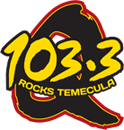KTMQ
 | |
| City | Temecula, California |
|---|---|
| Broadcast area | Temecula Valley Inland Empire |
| Frequency | 103.3 MHz |
| Branding | Q 103.3 |
| Programming | |
| Format | Active rock |
| Ownership | |
| Owner | iHeartMedia, Inc. (iHM Licenses, LLC) |
| KFOO, KGGI, KMYT, KPWK | |
| History | |
First air date | 2000 (as KFXM) |
Former call signs | KFXM (2000–2001) KGBB (2001–2004) |
Call sign meaning | K TeMecula Valley's Q103.3 |
| Technical information | |
| Facility ID | 85012 |
| Class | A |
| ERP | 1,250 watts |
| HAAT | 218 meters (715 ft) |
| Links | |
| Webcast | Listen Live |
| Website | q1033.iheart.com |
KTMQ (103.3 FM) is an active rock radio station that serves the Temecula Valley and Inland Empire areas. The station is owned by iHeartMedia, Inc.
Station origin[]
KTMQ launched in 2000 to simulcast the signal of KGB, and was called KGBB at launch. The KGB signal is very weak in southern Riverside County, from where many San Diego-area workers now commute daily. In 2005, the signal broke off to become a local station.
On February 14, 2011, Mötley Crüe's Nikki Sixx joined the KTMQ line up.
Programming[]
Program director and Wedding DJ Michael Dellinger a/k/a Mikie started as the mid-day host from 10 a.m. to 3 p.m. Pacific time. Dellinger plays modern rock and alternative music in addition to classic rock. He has now taken over as morning show host as of November 2012. KTMQ aired the Dave, Shelly, and Chainsaw morning show, which originated from 101.5 KGB in San Diego until its cancellation in January 2010. "Mikie" continued to host his ALL REQUEST LUNCHBOX during the morning/mid days until 11/2011. Mikie was moved to the morning show. November 2019 iHeart chose to used the KIOZ morning team to take over the mornings to replace Mikie's low rated morning show with the goal of increased morning drivetime revenues. Pushing Mikie Dellinger to the afternoon drive. November 2020 Mikie Dellinger was laid off and forced to return to wedding DJ services for the local budget minded wedding clientele full time. Nobody knows if it had to do with the 2020 COVID situation, or it was another down sizing plan, but most likely was based on poor station revenues being seen with reduced listership and ratings. This is a repetitive move for this cluster, where management realigns low rated stations and increases station revenues. Riverside iHeart knows how to increase station revenues by replacing non-revenue generating/low rating attributed on air talent/PD's.
External links[]
- Official Website
- KTMQ in the FCC FM station database
- KTMQ on Radio-Locator
- KTMQ in Nielsen Audio's FM station database
Coordinates: 33°28′52″N 117°11′02″W / 33.481°N 117.184°W
- Active rock radio stations in the United States
- Radio stations in California
- Radio stations established in 2000
- Temecula, California
- 2000 establishments in California
- IHeartMedia radio stations
- California radio station stubs
